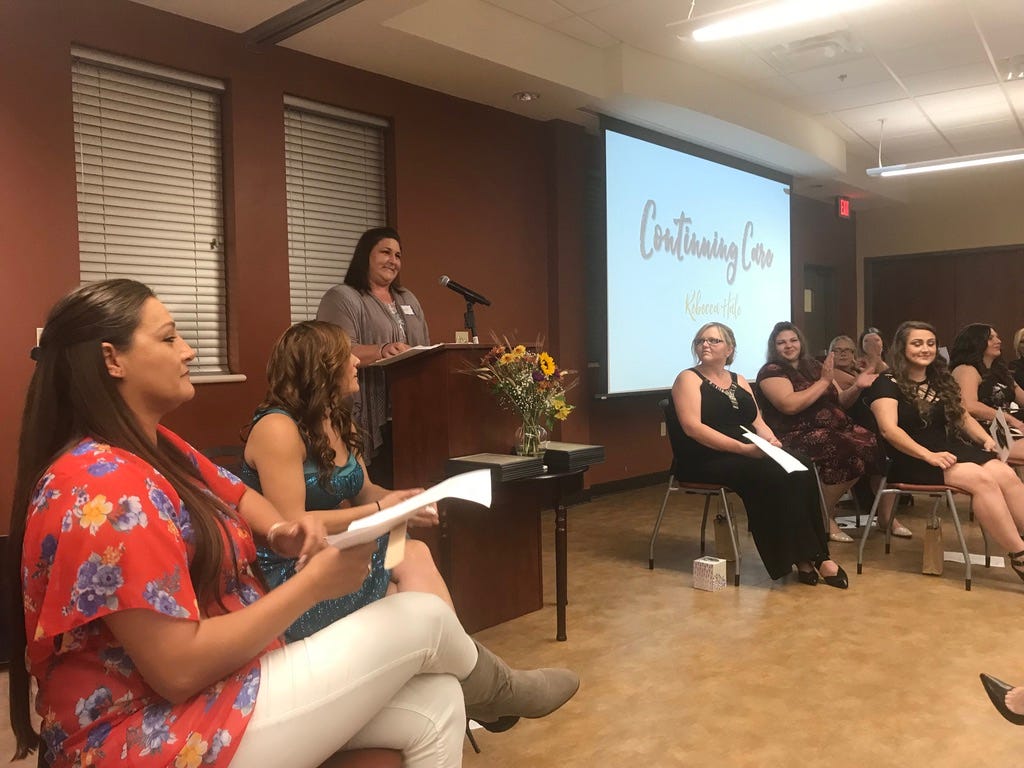"My Son Overdosed," She Confides
Instead of tackling the pandemic of addiction, we're letting it get worse.

They come up to me shyly and confide in a broken whisper: My son overdosed.
Or: My cousin is homeless because of alcohol and drugs.
Or, just a couple of days ago: My ex-husband is addicted.
When my wife and I go on the campaign trail in my new life as a candidate, we hear stories like that all the time. Since the pandemic began in March 2020, more people have died here in Oregon from substance abuse than from Covid-19.
Yet while we take far-reaching steps to reduce the coronavirus toll — with vaccines, masks and public health campaigns — we seem oddly relaxed about the devastation from substance abuse. A 15-year-old neighbor girl died recently from fentanyl, and it infuriates me that we don’t try as hard to save the lives of young people dying from drugs as we try to save the lives of adults dying from Covid-19.
“Oregon is gripped in the throes of a rapidly deteriorating substance use emergency,” a group of people in the field wrote Governor Kate Brown in September. They warned that a dozen substance abuse centers are closing down, with a particular crisis in programs for teenagers. “Our adolescent system is nearly decimated,” the letter cautioned.
One problem is that money, while available in the system, doesn’t reach the centers in time. Another is staff shortages. A third is a lack of urgency in finding remedies. These are the kinds of bureaucratic obstacles that America overcame when we faced Covid-19, and that can be solved in this space if we make the lives of kids and neighbors a top priority.
What does this failure mean in practical terms? It means that people die unnecessarily.
One old friend — smart, talented and funny — lost his job in the pandemic, and then self-medicated with heroin. He quarreled with his girlfriend, she went for a walk, and when she came back he was dead from an overdose. Perhaps it was suicide, but more likely he tried to console himself with heroin that was laced with more fentanyl than his body could handle.
I then tried to help his girlfriend, who also wrestled with addictions, get into a treatment program. But she has an anxiety disorder and is fearful of being around strangers, so she was herself ambivalent.
Her experience underscored to me again that helping people is hard, but that we have to do a better job of it. And that’s particularly true of services for mental health and substance abuse.
I’m asked all the time on the campaign trail about homelessness and about public safety issues: Oregon has the second worst rate of unsheltered homelessness in the country, and Portland just set a record for homicides. These are complicated problems that require a range of policies to address them. But part of the response has to be a much greater effort to treat people with mental health problems and with addictions — and it breaks my heart that instead, programs are shutting down just when they are most needed.
We Democrats have denounced Red states that have been cavalier about masking and vaccinations to deal with Covid-19. But we should look in the mirror: Here in Oregon, we have been too lackadaisical about providing treatment for people with urgent mental health and substance abuse needs. Especially when children are involved, this is unconscionable.
The Oregon Capital Chronicle has just run a terrific four-part series about the failing mental health system for children. It tells of a mom named Angela Weirich who tried desperately to get help for her 16-year-old daughter. The girl attacked family members, skipped school, ran away and repeatedly tried to commit suicide.
You’d think that with a life at stake, the system might respond. But it didn’t. The family couldn’t get a spot for the girl in a residential program. “Our daughter was going to die in Oregon,” Weirich told the Capital Chronicle.
So the family moved to Pennsylvania, where the girl was able to access the help she needed.
If anything, the problem is now getting worse. The behavioral health system for children is pretty much collapsing in Oregon, experts say, with long waits for care. Oregon children are often sent to out-of-state programs where they have no family member nearby, or no one to help if staff abuse them.
One national expert tells me that when he visited residential programs for troubled teenagers around the country, he was surprised to encounter Oregon children in state after state. He eventually realized that this was because Oregon didn’t have adequate treatment at home and sent its own children far away.
Maybe I’m framing this too much in policy terms. What all this means in the real world is shattered lives, devastated families and children languishing in foster care, on top of the 23,000 children who are homeless in Oregon. I think of my neighbors who lost their 15-year-old daughter and who can never be the same, and then I multiply that by thousands.
Some of my most emotionally wrenching reporting has been in hospital neonatal wards, watching newborns go through heroin withdrawal. They fuss, they cry, they are inconsolable — and this continues day after day.
I have a longstanding belief that we as a society are worst at addressing problems that are taboos or hard to talk about — because they involve embarrassing topics, from sex to domestic violence, mental illness to addiction. That’s probably why we have bungled our response to substance abuse.
As a journalist, I found that my spotlight was often most effective in shining a light on taboo topics, because this forced the issues onto the agenda. I’m planning to do the same thing as a candidate. I hope to win, of course, but I also want to elevate these difficult issues so that we can come up with better policies to manage them.
And I do believe that while these challenges are difficult, they are not impossible to address. I have friends who are alive today because programs worked. One friend of mine overdosed 17 times during the pandemic but is now getting medication-assisted treatment. Only about one-fifth of Americans with substance abuse problems get treatment, yet treatment pays for itself many times over.
In Tulsa, Oklahoma, a treatment program called Women in Recovery has a 95 percent success rate over three years, partly because it lasts longer than other programs and because it includes a component that gets people into jobs and raises incomes and self-esteem. It has saved Oklahoma more than $80 million because while treatment is expensive, incarceration is even more so.

In McMinnville, Oregon, I’ve admired a program called Provoking Hope that has worked with many of my friends to wean them from addictions. It started by simply offering people in trouble some soup, and a place to sit down. Later it offered group therapy and peer counseling, and it helped my friends start their lives over.
We need to increase access to these kinds of treatment programs, including medication-assisted treatment. (Medication-assisted treatment is not currently available for meth addictions, but research is promising and Oregon should pioneer that work.) We also need to understand that treatment takes time: It’s difficult to expect someone who has been addicted for a decade to overcome the dependency in a 30-day program.
I’ve been to too many funerals and seen too many children struggling in the shadow of their parents’ untreated addictions and mental health burdens. We need to do a much better job tackling the pandemic of despair, addiction and mental illness that afflicts our state and nation.




I have worked in harm reduction for nearly 20 years. I work internationally - not in the US. There are so many excellent programs that work so well, yet Americans seem almost totally unaware of them, and in the US, programs that are not best practice are set up again and again, spending a lot of $$, taking a lot of money from the most vulnerable people - ie users and their families are getting ripped off, and then the program does not work long-term for most people. The most likely time for someone to die from overdose is after they get out of one of those detox programs, because, when they relapse, they don't know how much is safe to take and they take the same dose that they were taking before detox. Switzerland is a good-practice example, and so is Portugal. UNODC has clear guidelines, and programs that follow those guidelines save lives. Key services are "medically assisted treatment" MAT (this is an American term, the rest of the world calls this opioid substitution therapy - OST) with methadone or buprenorphine (this is not a detox program - adequate dosing, longterm, NOT drawing down the dose, works best) and MAT should be outpatient, in community settings (not hospitals) with take-home doses. MAT should be easily available in jails and prisons too. Clean needles should be provided for HIV and Hep C prevention - I'll bet HIV infection rates are really high in injecting communities. Naloxone should be readily available for anyone to carry, especially users, because they are the ones most likely to be around people who are overdosing. Giving naloxone to police is very suboptimal, because most users avoid the police. There are also great international guidelines on rights-based programming for stimulant users - no mystery there, the evidence is already there and other countries are implementing those life-saving programs. An excellent program for women is Sheway, in Vancouver. There should be safe injection rooms - as there are in Canada and Switzerland. Nick Kristof - I am just telling you what works and the programs that have saved lives all over the world, and that the UN supports. There is no need for you to run around the United States trying to figure this out. There is a vibrant, informed community of people globally who know what needs to be done and know about all the excellent effective programs that exist. You could tap into that. The United States is abysmally behind and stubbornly unwilling or unable to learn from other countries. That is why there are so many dead Americans from overdose, and so few Swiss who die from overdose. Anyway - maybe this will help you - I won't put it on your Facebook page because the discussion is too vitriolic on Facebook and I am tired of being verbally assaulted by angry Americans. Good luck.
I am a retired treatment program developer and manager. Mr. Kristof is exactly right. We need more treatment programs pretty much everywhere and for people of every age. We need to stop using jails and prisons as treatment facilities. They are not equipped to do the job. We need treatment that addresses not just addiction itself but underlying mental illness that frequently accompanies it. We need to address systemic and family issues that exacerbate addiction. And we need follow-up for every patient, long term, not just a few weeks. It's easy to quit drugs (though not pleasant). It's much harder to stay off them. If we believe that addiction is an illness--and it is--then we need to treat it like one. We must give teachers and others who come into contact with young addicts the wherewithal to recognize drug use. I know from experience that many school teachers and counselors don't know the signs of addiction. Yet it is not uncommon for children as young as 8 or 9 years old to already be using drugs. I've known some who were even younger. Every state must put money into prevention and treatment. In the long run, it not only saves lives and families when we spend money up front, it also costs less, due to lower incarceration and fewer hospitalizations and deaths.